Zihao Fu
CAST: Compositional Analysis via Spectral Tracking for Understanding Transformer Layer Functions
Oct 16, 2025Abstract:Large language models have achieved remarkable success but remain largely black boxes with poorly understood internal mechanisms. To address this limitation, many researchers have proposed various interpretability methods including mechanistic analysis, probing classifiers, and activation visualization, each providing valuable insights from different perspectives. Building upon this rich landscape of complementary approaches, we introduce CAST (Compositional Analysis via Spectral Tracking), a probe-free framework that contributes a novel perspective by analyzing transformer layer functions through direct transformation matrix estimation and comprehensive spectral analysis. CAST offers complementary insights to existing methods by estimating the realized transformation matrices for each layer using Moore-Penrose pseudoinverse and applying spectral analysis with six interpretable metrics characterizing layer behavior. Our analysis reveals distinct behaviors between encoder-only and decoder-only models, with decoder models exhibiting compression-expansion cycles while encoder models maintain consistent high-rank processing. Kernel analysis further demonstrates functional relationship patterns between layers, with CKA similarity matrices clearly partitioning layers into three phases: feature extraction, compression, and specialization.
Evaluating Model Explanations without Ground Truth
May 15, 2025Abstract:There can be many competing and contradictory explanations for a single model prediction, making it difficult to select which one to use. Current explanation evaluation frameworks measure quality by comparing against ideal "ground-truth" explanations, or by verifying model sensitivity to important inputs. We outline the limitations of these approaches, and propose three desirable principles to ground the future development of explanation evaluation strategies for local feature importance explanations. We propose a ground-truth Agnostic eXplanation Evaluation framework (AXE) for evaluating and comparing model explanations that satisfies these principles. Unlike prior approaches, AXE does not require access to ideal ground-truth explanations for comparison, or rely on model sensitivity - providing an independent measure of explanation quality. We verify AXE by comparing with baselines, and show how it can be used to detect explanation fairwashing. Our code is available at https://github.com/KaiRawal/Evaluating-Model-Explanations-without-Ground-Truth.
CLIP-SENet: CLIP-based Semantic Enhancement Network for Vehicle Re-identification
Feb 24, 2025Abstract:Vehicle re-identification (Re-ID) is a crucial task in intelligent transportation systems (ITS), aimed at retrieving and matching the same vehicle across different surveillance cameras. Numerous studies have explored methods to enhance vehicle Re-ID by focusing on semantic enhancement. However, these methods often rely on additional annotated information to enable models to extract effective semantic features, which brings many limitations. In this work, we propose a CLIP-based Semantic Enhancement Network (CLIP-SENet), an end-to-end framework designed to autonomously extract and refine vehicle semantic attributes, facilitating the generation of more robust semantic feature representations. Inspired by zero-shot solutions for downstream tasks presented by large-scale vision-language models, we leverage the powerful cross-modal descriptive capabilities of the CLIP image encoder to initially extract general semantic information. Instead of using a text encoder for semantic alignment, we design an adaptive fine-grained enhancement module (AFEM) to adaptively enhance this general semantic information at a fine-grained level to obtain robust semantic feature representations. These features are then fused with common Re-ID appearance features to further refine the distinctions between vehicles. Our comprehensive evaluation on three benchmark datasets demonstrates the effectiveness of CLIP-SENet. Our approach achieves new state-of-the-art performance, with 92.9% mAP and 98.7% Rank-1 on VeRi-776 dataset, 90.4% Rank-1 and 98.7% Rank-5 on VehicleID dataset, and 89.1% mAP and 97.9% Rank-1 on the more challenging VeRi-Wild dataset.
Repetition In Repetition Out: Towards Understanding Neural Text Degeneration from the Data Perspective
Oct 16, 2023
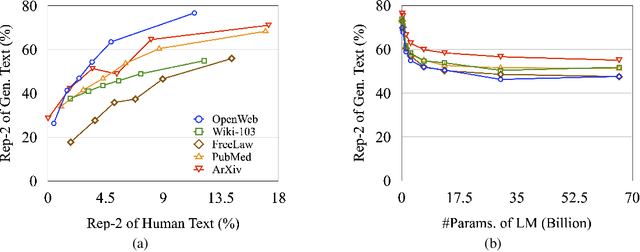
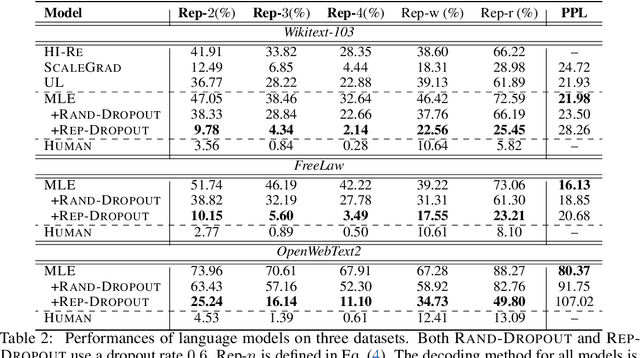
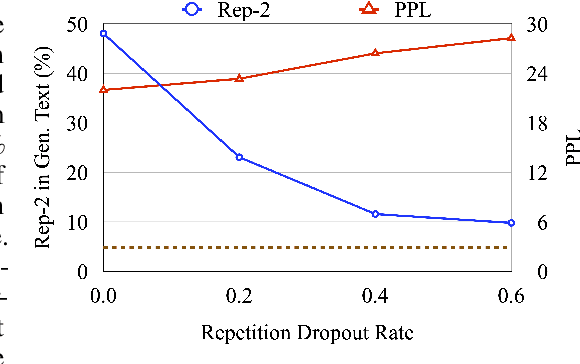
Abstract:There are a number of diverging hypotheses about the neural text degeneration problem, i.e., generating repetitive and dull loops, which makes this problem both interesting and confusing. In this work, we aim to advance our understanding by presenting a straightforward and fundamental explanation from the data perspective. Our preliminary investigation reveals a strong correlation between the degeneration issue and the presence of repetitions in training data. Subsequent experiments also demonstrate that by selectively dropping out the attention to repetitive words in training data, degeneration can be significantly minimized. Furthermore, our empirical analysis illustrates that prior works addressing the degeneration issue from various standpoints, such as the high-inflow words, the likelihood objective, and the self-reinforcement phenomenon, can be interpreted by one simple explanation. That is, penalizing the repetitions in training data is a common and fundamental factor for their effectiveness. Moreover, our experiments reveal that penalizing the repetitions in training data remains critical even when considering larger model sizes and instruction tuning.
BAND: Biomedical Alert News Dataset
May 23, 2023Abstract:Infectious disease outbreaks continue to pose a significant threat to human health and well-being. To improve disease surveillance and understanding of disease spread, several surveillance systems have been developed to monitor daily news alerts and social media. However, existing systems lack thorough epidemiological analysis in relation to corresponding alerts or news, largely due to the scarcity of well-annotated reports data. To address this gap, we introduce the Biomedical Alert News Dataset (BAND), which includes 1,508 samples from existing reported news articles, open emails, and alerts, as well as 30 epidemiology-related questions. These questions necessitate the model's expert reasoning abilities, thereby offering valuable insights into the outbreak of the disease. The BAND dataset brings new challenges to the NLP world, requiring better disguise capability of the content and the ability to infer important information. We provide several benchmark tasks, including Named Entity Recognition (NER), Question Answering (QA), and Event Extraction (EE), to show how existing models are capable of handling these tasks in the epidemiology domain. To the best of our knowledge, the BAND corpus is the largest corpus of well-annotated biomedical outbreak alert news with elaborately designed questions, making it a valuable resource for epidemiologists and NLP researchers alike.
Biomedical Named Entity Recognition via Dictionary-based Synonym Generalization
May 22, 2023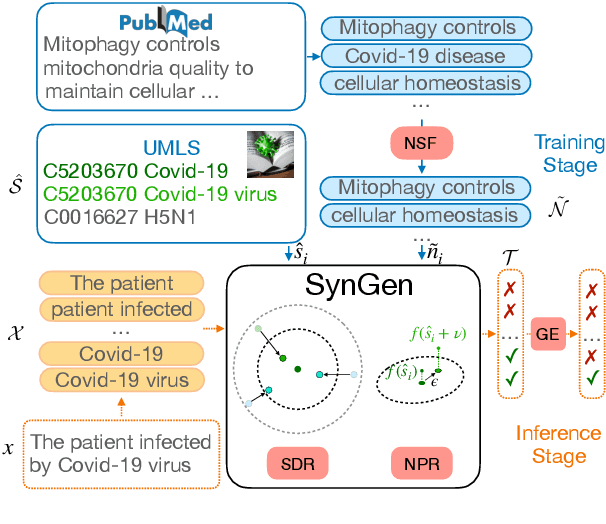
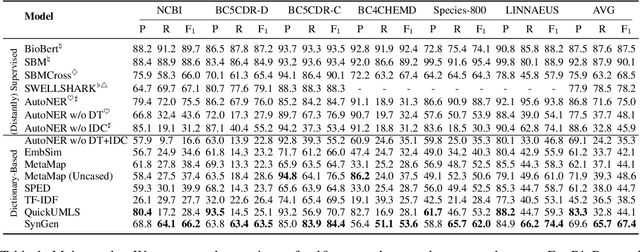
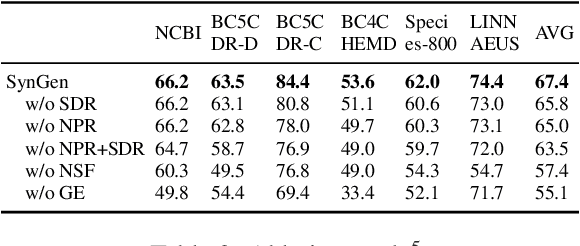
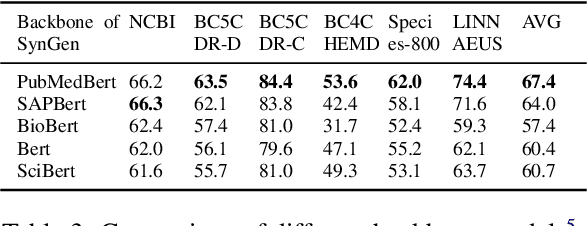
Abstract:Biomedical named entity recognition is one of the core tasks in biomedical natural language processing (BioNLP). To tackle this task, numerous supervised/distantly supervised approaches have been proposed. Despite their remarkable success, these approaches inescapably demand laborious human effort. To alleviate the need of human effort, dictionary-based approaches have been proposed to extract named entities simply based on a given dictionary. However, one downside of existing dictionary-based approaches is that they are challenged to identify concept synonyms that are not listed in the given dictionary, which we refer as the synonym generalization problem. In this study, we propose a novel Synonym Generalization (SynGen) framework that recognizes the biomedical concepts contained in the input text using span-based predictions. In particular, SynGen introduces two regularization terms, namely, (1) a synonym distance regularizer; and (2) a noise perturbation regularizer, to minimize the synonym generalization error. To demonstrate the effectiveness of our approach, we provide a theoretical analysis of the bound of synonym generalization error. We extensively evaluate our approach on a wide range of benchmarks and the results verify that SynGen outperforms previous dictionary-based models by notable margins. Lastly, we provide a detailed analysis to further reveal the merits and inner-workings of our approach.
Decoder-Only or Encoder-Decoder? Interpreting Language Model as a Regularized Encoder-Decoder
Apr 08, 2023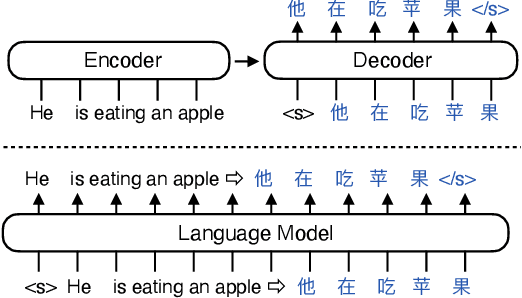


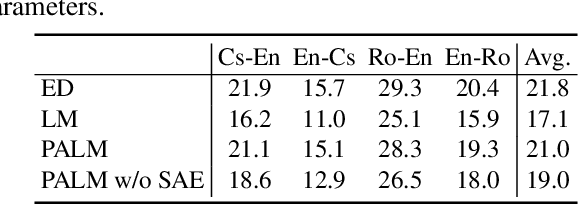
Abstract:The sequence-to-sequence (seq2seq) task aims at generating the target sequence based on the given input source sequence. Traditionally, most of the seq2seq task is resolved by the Encoder-Decoder framework which requires an encoder to encode the source sequence and a decoder to generate the target text. Recently, a bunch of new approaches have emerged that apply decoder-only language models directly to the seq2seq task. Despite the significant advancements in applying language models to the seq2seq task, there is still a lack of thorough analysis on the effectiveness of the decoder-only language model architecture. This paper aims to address this gap by conducting a detailed comparison between the encoder-decoder architecture and the decoder-only language model framework through the analysis of a regularized encoder-decoder structure. This structure is designed to replicate all behaviors in the classical decoder-only language model but has an encoder and a decoder making it easier to be compared with the classical encoder-decoder structure. Based on the analysis, we unveil the attention degeneration problem in the language model, namely, as the generation step number grows, less and less attention is focused on the source sequence. To give a quantitative understanding of this problem, we conduct a theoretical sensitivity analysis of the attention output with respect to the source input. Grounded on our analysis, we propose a novel partial attention language model to solve the attention degeneration problem. Experimental results on machine translation, summarization, and data-to-text generation tasks support our analysis and demonstrate the effectiveness of our proposed model.
COFFEE: A Contrastive Oracle-Free Framework for Event Extraction
Mar 25, 2023



Abstract:Event extraction is a complex information extraction task that involves extracting events from unstructured text. Prior classification-based methods require comprehensive entity annotations for joint training, while newer generation-based methods rely on heuristic templates containing oracle information such as event type, which is often unavailable in real-world scenarios. In this study, we consider a more realistic setting of this task, namely the Oracle-Free Event Extraction (OFEE) task, where only the input context is given without any oracle information, including event type, event ontology and trigger word. To solve this task, we propose a new framework, called COFFEE, which extracts the events solely based on the document context without referring to any oracle information. In particular, a contrastive selection model is introduced in COFFEE to rectify the generated triggers and handle multi-event instances. The proposed COFFEE outperforms state-of-the-art approaches under the oracle-free setting of the event extraction task, as evaluated on a public event extraction benchmark ACE05.
A Stability Analysis of Fine-Tuning a Pre-Trained Model
Jan 24, 2023



Abstract:Fine-tuning a pre-trained model (such as BERT, ALBERT, RoBERTa, T5, GPT, etc.) has proven to be one of the most promising paradigms in recent NLP research. However, numerous recent works indicate that fine-tuning suffers from the instability problem, i.e., tuning the same model under the same setting results in significantly different performance. Many recent works have proposed different methods to solve this problem, but there is no theoretical understanding of why and how these methods work. In this paper, we propose a novel theoretical stability analysis of fine-tuning that focuses on two commonly used settings, namely, full fine-tuning and head tuning. We define the stability under each setting and prove the corresponding stability bounds. The theoretical bounds explain why and how several existing methods can stabilize the fine-tuning procedure. In addition to being able to explain most of the observed empirical discoveries, our proposed theoretical analysis framework can also help in the design of effective and provable methods. Based on our theory, we propose three novel strategies to stabilize the fine-tuning procedure, namely, Maximal Margin Regularizer (MMR), Multi-Head Loss (MHLoss), and Self Unsupervised Re-Training (SURT). We extensively evaluate our proposed approaches on 11 widely used real-world benchmark datasets, as well as hundreds of synthetic classification datasets. The experiment results show that our proposed methods significantly stabilize the fine-tuning procedure and also corroborate our theoretical analysis.
On the Effectiveness of Parameter-Efficient Fine-Tuning
Nov 28, 2022



Abstract:Fine-tuning pre-trained models has been ubiquitously proven to be effective in a wide range of NLP tasks. However, fine-tuning the whole model is parameter inefficient as it always yields an entirely new model for each task. Currently, many research works propose to only fine-tune a small portion of the parameters while keeping most of the parameters shared across different tasks. These methods achieve surprisingly good performance and are shown to be more stable than their corresponding fully fine-tuned counterparts. However, such kind of methods is still not well understood. Some natural questions arise: How does the parameter sparsity lead to promising performance? Why is the model more stable than the fully fine-tuned models? How to choose the tunable parameters? In this paper, we first categorize the existing methods into random approaches, rule-based approaches, and projection-based approaches based on how they choose which parameters to tune. Then, we show that all of the methods are actually sparse fine-tuned models and conduct a novel theoretical analysis of them. We indicate that the sparsity is actually imposing a regularization on the original model by controlling the upper bound of the stability. Such stability leads to better generalization capability which has been empirically observed in a lot of recent research works. Despite the effectiveness of sparsity grounded by our theory, it still remains an open problem of how to choose the tunable parameters. To better choose the tunable parameters, we propose a novel Second-order Approximation Method (SAM) which approximates the original problem with an analytically solvable optimization function. The tunable parameters are determined by directly optimizing the approximation function. The experimental results show that our proposed SAM model outperforms many strong baseline models and it also verifies our theoretical analysis.
 Add to Chrome
Add to Chrome Add to Firefox
Add to Firefox Add to Edge
Add to Edge